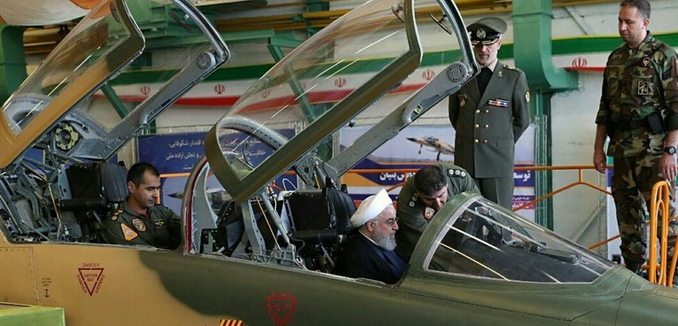With great fanfare, Iran unveiled what it called its first “indigenous” fighter jet outfitted with “advanced avionics,” this week. Top military officials were there for the unveiling of the Kowsar, as was President Hassan Rouhani, who even posed in the cockpit of the plane.
It didn’t take long before the hollowness of this achievement was exposed. Ofir Gendelman, Arabic language spokesman for Israeli Prime Minister Benjamin Netanyahu, tweeted, Iran’s new fighter jet was “in fact the same old 50-year-old American fighter f-5.”
While Iran boasted that the Kowsar had been tested, The Times of Israel reported that the video of the Kowsar released showed the plane on the runway but not actually flying.
Why would Iran put on such an empty show?
For one thing, the Islamic Republic has previously put on similar displays. The Times of Israel noted that in 2004, Iran unveiled a plane called the Saeqeh, which appeared to be based on the F-5, which Iran purchased in the 1960s. And in 2013, Iran unveiled what it claimed was its first domestic fighter jet called the Qaher-F313. But observers assessed that this plane was actually a plastic model that was too small to fly.
But why now?
Perhaps it’s because the Iranian regime is facing widespread dissatisfaction. Protesters around the country, who had been led to believe that the nuclear deal would give a boost to the economy have instead seen the economy stall, while the regime spares no expense in supporting foreign adventures and terrorist groups across the Middle East.
The priority given to Iran’s external affairs was expressed by protesters in June, who were heard chanting “Death to Palestine,” “No to Gaza, no to Lebanon” and “Leave Syria and think of us,” on social media.
There also appears to be growing resentment towards the privileged political class.
Following an earthquake in November of last year, The New York Times reported:
The earthquake has laid bare what many Iranians have been saying for a long time: Corruption inside state organizations has led to shoddy construction work and undermined Iran’s infrastructure.
Building permits can be bought, developers are allowed to economize on safety regulations and some quality-control inspectors make more of their living from bribes than salaries, insiders say.
Protests earlier this year focused on the lack of water available to many in Iran. Reuters reported at the time:
“What’s called drought is more often the mismanagement of water,” said a journalist in Varzaneh, who asked not to be identified because of the sensitivity of the subject.
“And this lack of water has disrupted people’s income.”
Writing in The Tower, Nik Kowsar described one aspect of this mismanagement:
This construction boom was spurred by consulting firms, politicians, and parliamentary candidates who saw large infrastructure projects as a way to consolidate their political support. The bigger the dam, the longer they would hold office. …
This cycle of corruption had predictable results: project managers rarely had the dams built on time, since the longer construction took, the more money the firms received. This also drove up costs, which filled the coffers of the IRGC and kept politicians in power, but resulted in ruinously expensive projects that produced few results.
The result has been that regular Iranians suffer from dangerous buildings and a lack of water, while the connected privileged class who’s responsible for these failures benefit financially.
The fact that the families of Iran’s politicians are open about their ostentatious lifestyle on social media has deepened the resentment of the governed for those governing. Increasingly Iranians are resentful of the “aghazadehs,” a term that refers to privileged Iranians who profit from political connections and family ties.
In this growing chasm between the regime’s elites and its citizenry Iran announced its supposed new locally produced fighter jet. Iran’s leaders like to boast of the regime’s military self-sufficiency. It’s a point of national pride.
Rouhani, this past April, declared that Iran will “produce any weapons that we need,” at the regime’s Army Day parade. He also struck a defiant tone that Iran “will not wait for your remarks or agreement,” to produce the weapons it needs.
At a time that the regime’s legitimacy is being openly questioned, it perhaps makes sense to make a show of self-sufficiency.
The need to show the Iranian people that it is capable of defending them apparently prompted the regime to unveil the Kowsar. But using an obsolete American plane to demonstrate its strength, shows the degree to which the regime is believing in an illusion.
Iran’s overspending on terror and foreign adventurism has damaged Iran’s economy. American sanctions threaten to further weaken the economy. Iran’s leaders may be telling themselves that everything is all right, but shoddy construction, a lack of water, and a phony fighter plane, suggest otherwise.
[Photo: Tasnim News ]




